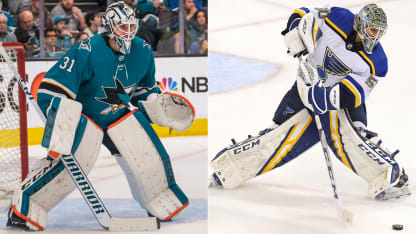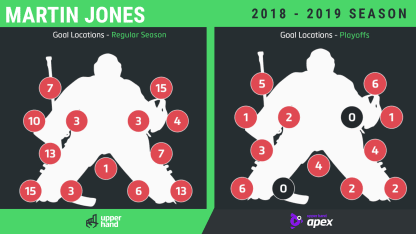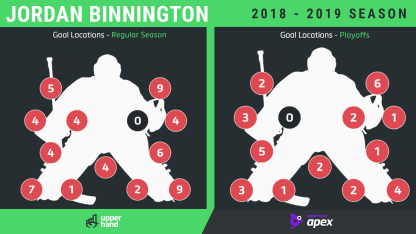Goaltending is an integral part of the Stanley Cup Playoffs. To better understand the strengths and weaknesses of each goalie, the last 100 goals allowed for each goalie in the regular season and every goal in the playoffs were charted, with the help of Apex Video Analysis and Save Review System from Upper Hand Inc., to see what patterns emerge.
Martin Jones vs. Jordan Binnington
Handling traffic around the net, low-high plays could decide Western Conference Final between Sharks, Blues

By
Kevin Woodley
NHL.com Independent Correspondent
St. Louis Blues goalie Jordan Binnington spent the first three months of the season playing in the American Hockey League. San Jose Sharks goalie Martin Jones had the worst save percentage (.896) of his NHL career in the regular season and was pulled twice in the first four games of the Western Conference First Round against the Vegas Golden Knights.
Now, as Binnington and Jones prepare to meet in the Western Conference Final, which starts with Game 1 at San Jose on Saturday (8 p.m. ET; NBC, CBC, SN, TVAS), it's hard to miss the similarities in their disposition off the ice that allowed them to overcome their individual challenges. Jones and Binnington may be quiet, but each also is confident in his game and ability, almost defiant at times in the face of criticism or doubters.
On the ice, it's the differences in style and strengths between Binnington and Jones, and the ability of each team to target the other goalie's weaknesses, that could determine which team reaches the Stanley Cup Final.
Here is an in-depth look at each goalie's game:
Martin Jones, San Jose Sharks
Jones' numbers and results weren't the only thing that changed after being pulled from Game 4 of the first round. After some uncharacteristic aggression played a role in an .838 save percentage in those first four playoff games, Jones appeared to back off on his initial positioning, especially against rush chances, which were an issue for the Sharks all season and perhaps a sign the sagging numbers weren't all the fault of their goalie. Since then, Jones has been deeper in his crease and quieter in his movements, limiting the exposure in some of his past movement inefficiencies and resulting in a .928 save percentage in his next 10 games, including two Game 7 victories.

GOAL TRENDS
Traffic and tips: In the constant give-and-take of goaltending, playing deeper in the crease to limit movement can leave goalies more vulnerable to screens, deflections and well-placed open shots. Jones gave up 18 screen goals in the regular season, below the average (21.2 percent) tracked on 6,000 recorded goals for the past three years of this project and down from last season (23). Screens played a role in 30 percent of the goals he allowed against Vegas, with Jones caught at times retreating in his crease behind traffic and dropping directly behind the screen rather than picking a side. His deflection goals during the regular season (20 percent) also were near the average (20.3), but tips have played a role in 10 of 36 so far in the Stanley Cup Playoffs (27.8 percent), including six of 16 (37.5 percent) in the second round. In a perfect world, goalies try to stay tight to the opposing player deflecting a puck, limiting how much the direction can change before it gets to them. Playing deeper makes that tougher and is a trend worth watching.
Beat the rush:Of the goals tracked on Jones in the regular season, 54 percent came off the rush, well above the 39.2 percent average. There were a lot of cross-ice passes on those rushes, high-quality chances that likely contributed to Jones' tough season statistically, and it continued early in the playoffs on all seven rush goals against Vegas in the first four games, including a couple clean shots from distance that went in because Jones was well outside his crease and lost his net. His approach since then has been more conservative, with the heels of his skates rarely far beyond the edge of the crease against the Avalanche, who scored five of 16 (31.2 percent) goals off the rush. Where Jones' aggression made plays down the wing effective because it's harder to keep up with quickly changing angles, deeper positioning typically is best attacked in the middle of the ice, though it's not like Jones has become too passive.
Left to right: Most goalies have one direction they move better, and Jones traditionally has been better going to his glove side, with a lack of early rotation the other direction leaving him more likely to push across flat instead of back toward his post. It's left him stranded outside his crease in the past, and though that happened less during the regular season, 19 of 36 playoff goals (52.8 percent) came on plays that forced Jones to move to his blocker side. That includes the lone goal he allowed in a 58-save performance in Game 6 against Vegas, a rebound chance made tougher because he got up from his butterfly on the wrong leg, delaying his ability to recover properly to his post.
Jordan Binnington, St. Louis Blues
Binnington got his first NHL start Jan. 7, almost eight years after being picked by the Blues in the third round (No. 87) of the 2011 NHL Draft, had a 25-save shutout and never looked back. With a balanced style and 59 goals to break down from the regular season, there weren't a lot of obvious tendencies going into the playoffs, which was reminiscent of Matt Murray's first Stanley Cup run with the Pittsburgh Penguins in 2016. But a few trends have emerged through two rounds.

GOAL TRENDS
Low-high attacks:Sharp-angled shots and plays from near or below the goal line that force Binnington to move in and off his posts accounted for seven goals in each round and 14 of the 32 goals (43.7 percent) in the playoffs so far. It's certainly not all on Binnington, with cross-ice backdoor plays and open shooters in high-danger areas after low-high passes on a lot of them, but with his playoff total on these types of plays more than double the average (17.4 percent), and so few weaknesses in his game otherwise, expect it to get a lot of attention. Although a lot of that focus in the first round was on the goal Winnipeg Jets defenseman Dustin Byfuglien banked in off the side of his mask from below the goal line, more often it has been side-to-side movement with the puck below the goal line that leaves Binnington behind on low-high plays.
Post play and wraparounds: Binnington has varied his post-seal approach as the playoffs have gone on, mixing a variety of techniques and at times trying to stay more patient before committing to any of them, which was key to a big save on Roope Hintz alone in the slot midway through the first period of Game 1 against the Dallas Stars in the second round. Still, whether it's leaving his back edge disengaged at times, leaning past the post using reverse-VH technique or having to turn his post skate before pushing across out of a VH technique, slight delays getting off his posts have made quick, far-side shots most effective on low-high plays. One constant in Binnington's approach identified before the playoffs has been a tendency to overlap his posts on sharp-angled net drives off the rush, starting with his short-side skate outside the post, which makes it tougher to push across, something that accounted for two wraparound goals in the regular season, a Kevin Hayes goal on a drive to the net for the Jets in Game 5 of the first round, two Stars goals and a couple close calls on wraparounds in overtime of Game 7 against Dallas.
Avoid the glove: Binnington doesn't play to extremes, so it's not surprising few numbers jump off the page of his goal chart, zone maps or scoring attributes. His high-glove totals may seem slightly higher but could be a factor of shot volume and quality from that side because his patience on glove saves has been exceptional, barely moving it to make a point-blank save on the Jets' Nikolaj Ehlers 5:33 into Game 1 of the first round and doing the same to deny Stars forward Radek Faksa on a breakaway 7:30 into Game 7 of the second round. Binnington can get a little more aggressive with initial positioning relative to the sides of his crease, staying wide on angled rushes and trusting his defense to take away backside chances. That increases the time it takes to get across on plays that do get through, so it's not surprising that same-side lateral plays (eight) and passes across the slot line (16) have played a factor in 75 percent of playoff goals (24 of 32) so far.
---
Listen: New episode of NHL Fantasy on Ice podcast

















